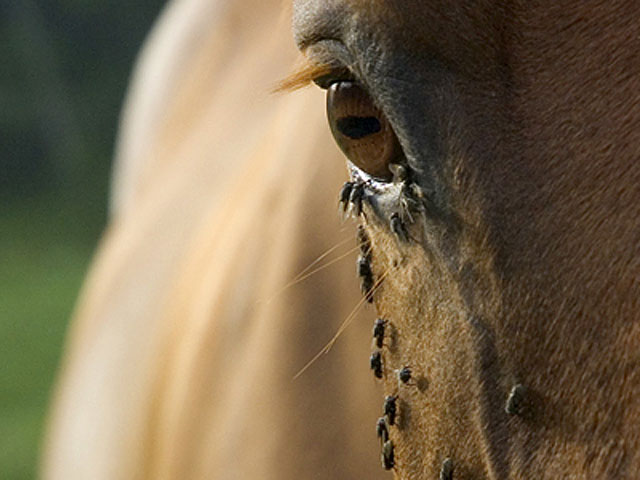
As summer approaches and the heat and rain move in, many horse farm owners anticipate a fierce fly season along with mosquito issues. Biting midges, often called no-see-ums or buffalo gnats, can also make summertime unbearable for horses.
When creating an insect warfare strategy to protect your horses, utilize nature and employ techniques that are safe and simple to implement. To initially reduce the population of insects on your farm, remove stagnant water, mow grass frequently to avoid overgrowth, and improve drainage on so the ground does not stay wet for extended period of time.
Beneficial Insects for Fly Control on Horse Farms
Some horse farm owners consider all insects pests. The Xerces Society, a 40-year-old worldwide nonprofit that works to conserve habitat for beneficial insects, reports that only about 2% of insects are pests. Many insects prey on each other—insects would overwhelm us if that was not the case. The Xerces Society also notes that beneficial insects provide at least 4.5 billion dollars in free pest management annually to the U.S. agricultural industry.
One example of a beneficial insect horse owners can put to work is parasitoid wasps. These gnat-sized, nocturnal insects lay their eggs in the developing pupae of flies, effectively reducing the fly population. They do not harm humans or animals and people rarely notice them since they are very small and active only at night.
Commercially raised parasitoid wasps can be purchased from several sources. To help control the fly population on your farm, release fly parasites early in the fly season according to the provider’s instructions.
Utilizing Insect-Eating Birds for Insect Control
Insect-eating birds are another effective nature-based approach for reducing soft-bodied, flying insects. Members of the swallow family can be an asset to a horse facility—one adult barn swallow consumes around 850 insects per hour.
Common North American insect-eating birds include violet-green swallows, tree swallows, barn swallows, bluebirds, purple martins, and cliff swallows (as opposed to house sparrows and European starlings, which don’t eat insects and tend to be nuisance birds). Encourage these birds to nest by hanging nest boxes specific to the types of birds on this list that in your area. Swallows, such as violet-greens, will use nesting material such as hair shed from horses or dogs.
For help determining the insect-eating birds specific to your part of the country and their nest box needs, consult your local Audubon Society, birding organization, extension office, wild bird store, or the library.
Bats for Insect Control on Horse Farms
Bats play an important part in every healthy environment because they eat nocturnal flying insects, such as mosquitoes, that can transmit disease-causing pathogens to humans and horses. Some bat species can consume 1,000 or more insects in an hour. A nursing female bat eats the most, consuming about 4,000 insects per night.
You might be able to encourage a bat family to move to your property by hanging a bat box built specifically for the types of bats common in your region. Place bat houses on the southern exposure of a barn, pole, tree, or house, preferably within a half mile of a stream, lake, or wetland. If your farm is in the Northern Hemisphere, place bat houses by early April and be patient because it can take up to two years for a bat colony to find your house.
Rabies can be carried by bats (or any warm-blooded animal), so be sure your horses are current on their rabies vaccination. And just as you would do with a stinging insect or an unfamiliar dog, always leave bats alone to minimize your risk of disease.
Take-Home Message
When managing insects on your horse farm, first strive to reduce where they live and breed, which is mud, manure, and stagnant water. After you have these areas under control, you can help reduce insect populations with birds, bats, and parasitoid wasps.
Using these techniques as your first line of defense will help reduce the amount of chemicals you need to use around your property and lessen your negative impact on the environment. Fewer flies and fewer chemicals lead to a healthier environment for you and your horses.



